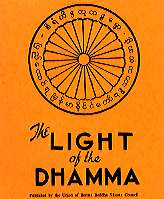|
Being the first discourse of the first Nikaya, the
Brahmajala (Great Net) is an important discourse.
To us in Burma it is doubly important, because this very discourse was
delivered at Suvannabhumi by Sona and Uttara, the first
Buddhist missionaries who came to Burma in the 3rd century B.C.
It is mentioned in the Sasanavamsa that
Sona and Uttara after driving away an ogress recited the Brahmajala sutta which
caused the conversion of sixty thousand people to the new faith, while 3,500
young men and 1,500 girls of noble family entered the Order.
The Brahmajala sutta consists of two parts, the Sila (morality)
section comprising the small, medium and great section, and the philosophical
portions in which the various philosophical views held by individual
philosophers or schools of philosophy are discussed.
From the section on morality we come to know how the Buddha was head
and shoulders above all the contemporary teachers as regards morality and
discipline. And from the philosophical portions it becomes clear that the
Buddha was the greatest of the philosophers. If we understand the Brahmajala
sutta we shall correctly understand the Buddha’s doctrines.
The moral precepts are arranged according to the number—the
concise section contains a small number of moral precepts and very important
ones at the same time. The medium section contains a number of moral precepts
in the form of certain practices and occupations followed by some schools of
brahmins and monks. But the Blessed One and his monks avoided those practices
and occupations. Similarly the elaborate section contains a large number of
secondary professions by means of which the brahmins and monks of some schools
earned their living, which the Blessed One and his disciples refrained from
following. It is important to note that the Buddha’s Teaching of morality was
of a much higher order than that of some of the Brahmanical and non-Brahmanical
sects, whose members did not consider it sinful to practise, for example,
gambling, accepting gifts of maidens and women, and such things as land and
cattle and to earn their livelihood by various questionable means, like
foretelling the future, causing abortion, deafness and dumbness, etc. The study
of the section on precepts on morality gives us also a glimpse into certain
social customs and practices, occupations and professions, games and sports,
certain arts and sciences such as astrology, physiognomy and medical science of
ancient India.
In the philosophical portion we find descriptions of various views
under the heading of Pubbanta-kappa and
Apparanta-kappa (Speculation relating to the past
and speculation relating to the future). The discussions mainly centre round
the soul and the world—two important subjects discussed in all
philosophies—the world and the soul theories relating to the past are
discussed under Pubbanta-kappa and those relating to the future are discussed
under Aparanta-kappa. Besides the questions of the world and the soul other
questions such as what is moral (Kusala), what is immoral (Akusala), whether
the soul and the body are the same or different (tam jivam tam sariram) - one
of the 10 Indeterminates—and whether there are beings opapatika satta * etc. are discussed. There are
mentioned sixty-two views altogether.
Strictly speaking, the number of views is eight, namely
Eternalism, Semi-Eternalism, Extensionism, Eel-wriggling,
Fortuitous- origination, Existence after death, Annihilationism and
Hedonism, the doctrine of happiness in this life. (Sassata-vada, Ekacca-sassata ekacca-asassata, Antanantika,
Amaravikkhepa, Adhiccasamuppada; Uddhamaghatanika, Uccheda and Dittha
dhamma-nibbana vada). But each of these views is divided into several
parts and these parts are regarded as separate views. Some of the views can be
identified; for example Annihilationism No. 1 is the same as that held by Ajita
of the hair blanket Eternalism No. 1 is the same as the view of Pakudha
Kaccayana one of the heretical teachers. Rhys Davids in his American Lectures
refuted the view of Garbe that the Eternalism was the Sankhya view. All the
views could not be actually held, but they were logically formulated so that no
view might be left out of this Great Net.
The Blessed One divided speculation relating to the past under 18
grounds, for instance, under the heading of Eternalism there exist four
views,
that is 4 grounds on which Eternalist views were held. The
Eternalists held the view that the soul and the
world are eternal, giving birth to nothing new, is steadfast as a
mountain peak
and is as a pillar firmly fixed. They believed that the living creatures
run on
and pass away, fall from one state of existence and spring up in another
yet
they are for ever the same. Those who held the Eternalism No. 1 could
remember
by means of meditation a hundred thousand previous births; those who
held No. 2
could remember past existences to the extent of ten world aeons,
similarly No.
3 up to forty world aeons. As for the 4th group, they were the logicians
who
held the Eternalism by logical reasoning and not by practising
concentration
like the other three groups. These brahmins and monks who remembered
their past
came to the conclusion that the soul and the world which had persisted
through
those long periods must be permanent. But any such conclusion is wrong,
for
they moved within the domain of Nescience (Avijja), and Nescience is
beginningless (anamatagga). One under the influence of Nescience cannot
know the Truth.
Under the same heading of Speculation relating to the past,
Semi-eternalist view’s are mentioned. Those who came from the Abhassara world
of Radiance and were reborn in the world of Brahma gods thought that Brahma who
was reborn in that world first, was permanent, eternal, and they themselves who
had to pass away from that Brahma world and were reborn in the human world were
impermanent. So they held the Semi-eternalist
view. Similarly, those who were gods called the “Debauched by Pleasure
(Khidda-padosika) and the “Debauched in mind” (Mano-padosika) were
reborn in the human world and took the same view thinking they themselves were
impermanent while those who were not spoiled by sport and were not envious were
permanent. Fourthly those who were addicted to logical reasoning held that view
by believing that the five senses namely the eye, the ear, (he nose, the tongue
and the body are impermanence while the mind or consciousness is eternal. it
may be mentioned here that whether it is a god or Mahahrahma or our mind or
consciousness, everything is impermanent and therefore the semi-eternalist view
is wrong. It may be noted that in the list of 10 indeterminates there is
mention of the world as eternal and the world as not eternal but here we have
world as well as soul; besides, the Semi-eternalist view is not mentioned in
the 10 Indeterminates.
The Extensionist views are mentioned in
four groups, three of them holding their view as usual due to their knowledge
born of concentration and the last one by logical reasoning. Some believed that
the world is finite and others believed that it is infinite some believed that
it is finite in the upwards and downwards directions and is infinite across.
Another group held that it is neither finite nor infinite, by logical
reasoning. Here they did not say anything about the soul. It may be added that
in the list of 10 indeterminates we have only the world as finite and the world
as infinite, and not the other two mentioned here. The theories regarding the
nature of the world or universe which certain monks and brahmins formulated did
not interest the Buddha who regarded such discussion as useless for it does not
help us to attain the goal of life which is making an end of
suffering.
The Equivocators (Amaravikkhepikas) or
the eel-wrigglers refused to answer definitely the question whether this is
good or bad (idam kusalam, idam akusalam), because they were afraid of telling
lies, which will hinder their spiritual progress. Some were afraid of being
influenced by feeling (chanda), desire (raga), ill-will (dosa) and hatred
(patigha), which might cause them attachment (upadana) and thus become a
hindrance on their way to the goal. Some dared not discuss with other teachers
as they would not be able to explain the reasons for their answers and so they
avoided by saying “This is not my view (Evam pi me no), the other also is
not my view (Tatnanti pi me no) different is not also my view (annatha ti pi me
no), “is not” is also not my view (No ti pi me no), and “not
not” is also not my view (No no ti pi me no)., Last of all some due to
their stupidity gave the same answers in reply to the questions—whether
there is another world or not, whether there are chance-born beings or not,
whether there is result of good or bad deeds or not, whether any sentient being
continues to exist or not after death, both exists and does not exist, neither
exists nor does not exist after death. By reading these we find how those
Equivocators were timid and stupid. The last four questions are the same as the
last four Indeterminates—these questions the Blessed One also refused to
answer not because of ignorance but because the posthumous state of an arahant
defies description besides, it is unprofitable to discuss them.
As regards the other questions which Sanjaya avoided, the Buddha’s
view was definite, namely whether there is the next world or not or whether
there is result of good or bad deeds or not.
Sanjaya Belatthiputta the heretical teacher was an eel-wriggler and
he discussed the questions beginning with “Is there another world ?”
(atthi paraloka) etc. The eel wrigglers were not interested in the theories of
the soul and the world.
Another class of teachers held the Fortuitous-originist views, and they said the world and
the soul arise without reason. Those who came down from the world of
Unconscious Beings (Asannasatta deva loka), by means of their exertion attained
concentration which led them to think that the soul and the world are
fortuitous in origin. They thought that they not having been, had come into
being. Some held that view by a process of reasonings. This unscientific
doctrine is the opposite of the Law of Causal genesis (Paticcasamuppada)
formulated by the Buddha.
Thus we get 18 views of those who reconstructed the ultimate
beginnings of things. The Brahmajala sutta further mentions the Speculators on
the future (Aparanta Kappikas) who arranged the future on forty-four grounds.
Here we find under the heading of the views regarding conscious existence after
death (Uddhama ghatanika sanni vada), sixteen views about a conscious existence
of the soul after death. They said that the soul after death is conscious and
not subject to decay. They differed from each other in deciding whether the
soul has—1. form or, 2. not, 3. has and has not form, 4. neither has nor
has form, 5. is finite or 6. infinite, 7. both finite and infinite, 8. neither
finite nor infinite, 9. has one mode of consciousness, 10. has various modes of
consciousness, 11. has limited consciousness, 12. has infinite consciousness,
13. is happy or, 14. miserable, 15. both happy and miserable, 16. neither happy
nor miserable.
Speculators about the unconscious existence after death
(Uddham=aghatanika asanni vada) were those who held eight views on an
unconscious existence after death. The details are the same as under conscious
existence up to number 8 of the above list.
And some held that the soul is neither conscious nor unconscious
(Uddham aghatanika neva sanni na sanni) on the same eight grounds as under
unconscious existence mentioned above. In brief the future conditions of the
soul have been discussed under three heads namely—1. Conscious existence
of the soul after death. (Uddham aghatanika sanni vada) 2. Unconscious
existence of the soul after death. (Uddham aghatanika asanni vada) 3. Neither
conscious nor unconscious existence of the soul after death. (Uddham aghatanika
nevasanni sanni vada.
These views are different ramifications of one question namely the
condition of the soul after death. It may also be noted that these theorists
were not interested in the question of the nature of the world. The Buddha
showed the fallacy of belief in the existence of a soul surviving after death
as believed by them. The so-called soul is nothing but successive states
mistaken for an entity.
Then we find the Ucchedavada which was held by Annihilationists who in seven ways maintained the
cutting off, the destruction, the annihilation of a living being. The first
variety of this doctrine was held by Ajita Kesakambali. The Annihilationists
said that the soul after death is cut off, destroyed and is annihilated. They
mentioned seven different kinds of souls namely:
1. The soul which is a product of the four elements (mahabhutas) 2.
which is divine, has form, belongs to the sensuous plane and feeds on solid
food, 3. which is divine and has form and made of mind, 4. which has attained
the sphere of infinity of space (akasanancayatana), 5. infinity of
consciousness (vinna nanancayatana, 6. nothingness (akincannayatana), 7. sphere
of neither consciousness nor unconsciousness (neva-sanna-nasannayatana). They
all said that those various souls are annihilated after death and there is a
complete end of a being. We find that the annihilationists are just the
opposite of the Eternalists. From this we know that the Arupajjhanas were
pre-Buddhistic, and this can also be proved from the
Aruapariyesana sutta wherein Alarakalama and Uddaka Ramaputta who held
the doctrines of Nothingness (Akincinnayatana) and neither consciousness nor
unconsciousness (Neva sanna nasanna-yatana) respectively, are mentioned as the
philosophers under whom the Bodhisatta practised meditation of the immaterial
sphere (Arupajhana). The Annihilationists regarded the body or a subtle kind of
body or even the stages of Arupajjhanas as souls. It may be remarked that these
soul theorists are necessarily annihilationists. The Buddhists are neither soul
theorists nor annihilationists. There is continuity after death till the
attainment of Nibbana, but not the continuity of a soul. Thus in Buddhism the
two views Annihilationism and Eternalism are avoided and reconciled.
Ditthadhamma-nibbana vadas were held by those who believed in the
doctrine of happiness in this life on five
grounds, namely 1. one can get happiness (Nibbana) when one’s soul is in full
five pleasures of the senses, 2. when one attains first jhana, 3. second jhana,
4. third jhana, and 5. fourth jhana. Thus we find that they considered
the fullest enjoyment of all the sense pleasures or the happiness derived from
the attainment of the four stages of meditation (Rupajjhana) to be equivalent
to Nibbana. But our Blessed One had mentioned in the Dhammapada that Nibbana is Paramasukha, which is far
exceeding the happiness born of jhanas. According to this the four Rupajjhanas
appear to have been practised by the monks and brahmins at the time of the
Buddha and these, like the Formless Meditation (Arupajjhanas), were
pre-Buddhistic practices.
At the end of each of the views the Buddha declared that in contrast
there are doctrines which are profound, difficult to perceive, difficult to
understand, tranquil, excellent, beyond the reach of reasoning, understandable
only by the wise. In the Ariyapariyesana sutta ( Majjhima
Nikaya) the same adjectives are used in connection with the causal
genesis (paticcasamuppada), the conditioned
origination (idappaccayata), the cessation of all
the predispositions (sabba samkhara-samatha), the
abandonment of all the bases of life (sabba upadhi
patinissagga), Nibbana etc. Therefore it is clear that the doctrine of
Nibbana is the profound doctrine preached by the Buddha which is higher than
the views preached by the monks and brahmins.
The Buddha declared that these sixty-two views are based upon
sensation (Vedana) which is caused by contact
(phassa) and which leads to craving (tanha), and craving naturally leads to rebirth and
suffering. So the Buddha advised his disciples not to follow those doctrines,
as Nibbana cannot be attained by the contact of the mind with the 6 sense
objects, which are impermanent. One must go beyond mind in order to attain
Nibbana. The stage of neither consciousness nor unconsciousness which the
Bodhisatta had attained under Uddaka Ramaputta was a very subtle state of mind
and therefore the Bodhisatta instinctively felt that the highest goal was not
yet reached. And so he left him, and by his own effort attained to the complete
cessation of both perception and sensation (Sanna-Vedayita Nirodha) stage and then to Nibbana.
The great significance of the sutta may be judged from the statement
made at the end of the sutta that the ten thousand world systems shook when
this discourse was being delivered by the Buddha. No such incident is reported
to have happened when other important discourses like Samannaphala sutta were delivered.
* Opapatika
(Lit. “Accidental”) satta—”Spontaneously born
beings, i.e, born without the instrumentality of parents. This applies
to all heavenly and infernal beings”.
“After the disappearing of the five lower fetters he appears
(spontaneously) in a spiritual world,” ®
(Majjhima Vol 1. )
Nivapasutta
|






















